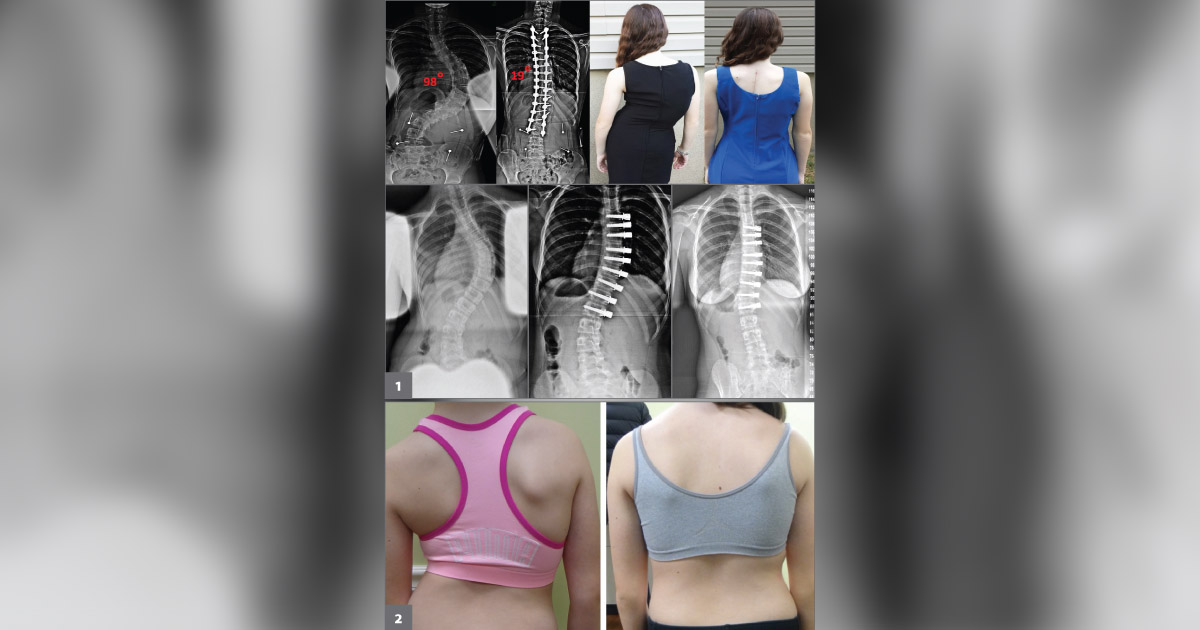Scoliosis amenable to correction with non-fusion vertebral body tethering
Click Here to Manage Email Alerts
Idiopathic scoliosis is a lateral or side curvature of the spine that is a 3D deformity presenting most commonly in the adolescent patient.

Idiopathic scoliosis is seen in 2% to 3% of the adolescent population. Most patients with idiopathic scoliosis do not require interventional treatment but rather observation to be certain curve progression does not occur or bracing for curvatures from 25° to 40°.
In growing adolescents in whom curve progression greater than 40° occurs or who have failed bracing, surgery is indicated. Approximately one in 10 or fewer patients afflicted with scoliosis are indicated for surgery. Patients with scoliosis in the operative range often have significant body image and psychosocial disturbance and may experience pain and some limitations in activity. If left untreated, the patient may present as an adult with debilitating pain and loss of function. In patients with the most severe curves, respiratory compromise may occur.
Instrumented fusion
The standard surgical treatment for scoliosis entails an arthrodesis or fusion in which segments of the spine are instrumented with screws and two metallic rigid rods and a biological welding (fusion) of each motion segment to one another occurs over several months (Figure 1).
Fusion has been the method of treatment for correcting scoliosis for the past century from the first arthrodesis procedures performed by Russell A. Hibbs, MD, and Fred H. Albee, MD, in New York City at the turn of the 20th century and is now the gold standard to which other procedures will be compared. Arthrodesis was the old paradigm for treating severe hip and knee osteoarthritis, which is now treated by joint arthroplasty.
Spine surgery has lagged behind in the ability to preserve spinal motion and spinal health in the scoliotic condition until recently. The FDA approved, for the first time, two non-fusion scoliosis correction devices. These are The Tether Vertebral Body Tethering System (Zimmer Biomet Spine), which is the subject of this article, and the ApiFix (OrthoPediatrics), a posterior dynamic distraction system.

Source: Baron S. Lonner, MD
Partial curvature correction
The VBT procedure is performed by approaching the spine through small incisions in the patient’s side (thorax and/or abdomen) and utilizing a scope and video camera to place screws across the vertebral bodies within the curved scoliotic spine and then attaching a tether or cord, providing partial correction of the curvature. As the patient grows, the curve corrects further in a process called “growth modulation” in which wedge-shaped vertebrae square off and the spine straightens (Figure 2). The advantage of this procedure is that it is motion-sparing and does not stiffen the spine. Fusion places greater stresses on adjacent segments of the spine which can cause disc degeneration and back pain over the years. In a 10-year multicenter follow-up study, performed with the Harms Study Group under the umbrella of the Setting Scoliosis Straight Foundation, my team and I showed increasing percentages of patients with significant disc degeneration as fusions extend into the lower lumbar spine in patients who were typically aged 20 to 29 years. The operation is also associated with a more rapid recovery from surgery than fusion with less blood loss. We routinely allow patients to return to their sport(s) of choice beginning at 6 weeks after surgery and permit gentle swimming after 4 weeks.
Many of our patients are athletes, including swimmers, dancers and gymnasts, who require and desire as much spinal flexibility as possible, and seek out this procedure with their families. In my first nearly 300 cases, we have not had to provide a blood transfusion to any patients.
The promise of VBT will only be determined after further follow-up and completion of longer-term studies that compare outcomes to those of the standard spinal fusion procedure. I remain optimistic about the present and future of non-fusion scoliosis correction.
Click here to watch video of this technique.
- Reference:
- Samdani AF, et al. Eur Spine J. 2015;doi.org/10.1007/s00586-014-3706-z.
- For more information:
- Baron S. Lonner, MD, chief of minimally invasive scoliosis surgery, Mount Sinai Hospital, can be reached at 1468 Madison Ave., New York, NY 10029; email: stacy.anderson@mountsinai.org.
